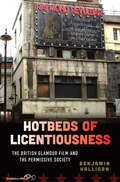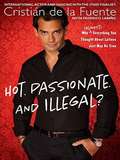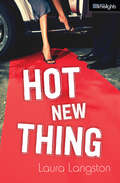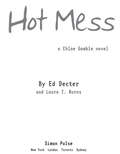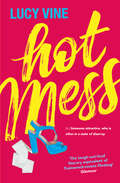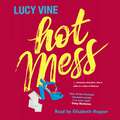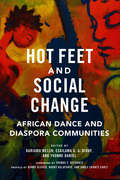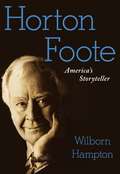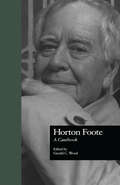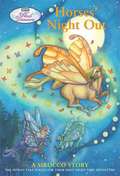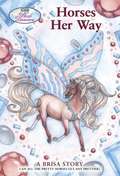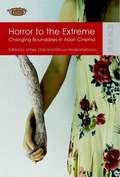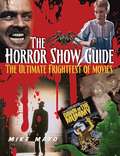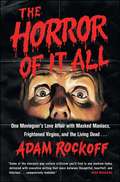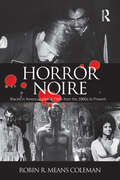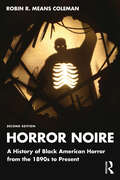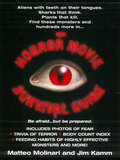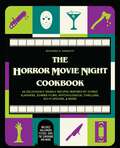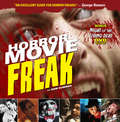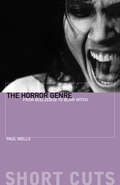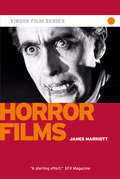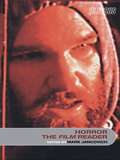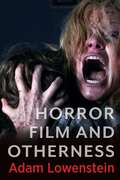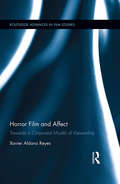- Table View
- List View
Hotbeds of Licentiousness: The British Glamour Film and the Permissive Society
by Benjamin HalliganHotbeds of Licentiousness is the first substantial critical engagement with British pornography on film across the 1970s, including the “Summer of Love,” the rise and fall of the Permissive Society, the arrival of Margaret Thatcher, and beyond. By focusing on a series of colorful filmmakers whose work, while omnipresent during the 1970s, now remains critically ignored, author Benjamin Halligan discusses pornography in terms of lifestyle aspirations and opportunities which point to radical changes in British society. In this way, pornography is approached as a crucial optic with which to consider recent cultural and social history.
Hot. Passionate. and Illegal?
by Cristian de la Fuente Federico LarinoFrom Dancing With the Stars finalist Cristian de la Fuente comes a tongue-in-cheek guide to understanding Latino culture-now in paperback. As a contestant on Dancing with the Stars, international star and actor Cristián de la Fuente automatically assumed the role of the flashy Latino dancer, donning bright fuchsia costumes with his bare chest exposed. But Cristián ultimately wowed the judges and reached the finals-not with his fancy footwork but with his charm. Quickly, the producers and viewers learned that just because someone is Latino does not necessarily mean he can dance... And Cristián proved Latinos can and should not be reduced to one-dimensional definitions. In Hot. Passionate. And Illegal?, Cristián uses his personal and funny experiences as a Latino in Hollywood to dispel common myths and admit the sometimes embarrassing, yet endearing, truths about Latinos.
Hot New Thing (Orca Limelights)
by Laura LangstonLily is discovered by a big-name director when she’s auditioning for a role in a toothpaste commercial. He wants her for his new movie, which is great except for the fact that it’s shooting in Los Angeles and Lily lives in Vancouver. With the help of her Chinese grandmother, she convinces her parents to let her go to LA with her agent as a chaperone. But when she gets there, she finds out that if she wants to be more than the flavor of the week, she’s going to have to pay a price that may be way too high.
Hot Mess (Chloe Gamble #3)
by Ed DecterThe final book in the rags-to-riches-to-rags trilogy that reads like an E! True Hollywood Story.
Hot Mess: The utterly hilarious and relatable Number One eBook bestseller
by Lucy VineThe eBook Number One bestseller The hottest book of the summer. A sassy, laugh out loud beach read everyone is talking about *****Hot Mess [n.] - someone attractive, who is often in disarray.Have you ever shown up to Sunday brunch still smelling of Saturday night?Chosen bed, Netflix and pizza over human contact?Stayed in your mould-ridden flat because it's cheap?Meet your spirit animal, Ellie Knight. Her life isn't turning out exactly as she planned. She hates her job, her friends are coupling up and settling down, and her flatmates are just plain weird.Some people might say she's a hot mess but who really has their sh*t together anyway? For fans of Fleabag and Girls, this is a fresh and funny coming-of-age story with a single-girl heroine that will speak to millennials everywhere.*****'The laugh-out-loud literary equivalent of Trainwreck-meets-Fleabag' Glamour'A breath of fresh air, deftly subverting some of chick lit's biggest clichés' Stylist'More lifestyle-affirming than Bridget Jones' Sarah Knight, author of The Life Changing Magic of Not Giving a F*ck'If you love dirty jokes, dating horror stories and hilarious dialogue, this book is for you' Emma Gannon, author and podcast host of Ctrl Alt Delete'I laughed and sighed with recognition as I turned every page' Daisy Buchanan, author of How To Be a Grown-Up
Hot Mess: Bridget Jones for a new generation
by Lucy VineHot Mess [n.] - someone attractive, who is often in disarray.Have you ever shown up to Sunday brunch still smelling of Saturday night?Chosen bed, Netflix and pizza over human contact?Stayed in your mould-ridden flat because it's cheap?Meet your spirit animal, Ellie Knight. Her life isn't turning out exactly as she planned. She hates her job, her friends are coupling up and settling down, and her flatmates are just plain weird.Some people might say she's a hot mess but who really has their sh*t together anyway? For fans of Fleabag and Girls, this is a fresh and funny coming-of-age story with a single-girl heroine that will speak to millennials everywhere.Everyone is talking about Hot Mess - the hilarious laugh-out-loud Bridget Jones for a new generation:'More lifestyle-affirming than Bridget Jones' Sarah Knight, author of The Life Changing Magic of Not Giving a F*ck'If you love dirty jokes, dating horror stories and hilarious dialogue, this book is for you' Emma Gannon, author and podcast host of Ctrl Alt Delete'I laughed and sighed with recognition as I turned every page' Daisy Buchanan, author of How To Be a Grown-UpRead by Elisabeth Hopper(p) Orion Publishing Group 2017
Hot Feet and Social Change: African Dance and Diaspora Communities
by Kariamu Welsh Esailama G. A. Diouf Yvonne DanielThe popularity and profile of African dance have exploded across the African diaspora in the last fifty years. Hot Feet and Social Change presents traditionalists, neo-traditionalists, and contemporary artists, teachers, and scholars telling some of the thousands of stories lived and learned by people in the field. Concentrating on eight major cities in the United States, the essays explode myths about African dance while demonstrating its power to awaken identity, self-worth, and community respect. These voices of experience share personal accounts of living African traditions, their first encounters with and ultimate embrace of dance, and what teaching African-based dance have meant to them and their communities. Throughout, the editors alert readers to established and ongoing research, and provide links to critical contributions by African and Caribbean dance experts.Contributors: Ausettua Amor Amenkum, Abby Carlozzo, Steven Cornelius, Yvonne Daniel, Charles “Chuck” Davis, Esailama G. A. Diouf, Indira Etwaroo, Habib Iddrisu, Julie B. Johnson, C. Kemal Nance, Halifu Osumare, Amaniyea Payne, William Serrano-Franklin, and Kariamu Welsh
Horton Foote
by Wilborn HamptonNo playwright in the history of the American theater has captured the soul of the nation more incisively than Horton Foote. From his Pulitzer Prize-winning play, The Young Man From Atlanta, to his film adaptation of To Kill a Mockingbird, which received an Oscar, millions of people have been touched by Foote's work. He has long been regarded by other playwrights and screenwriters, actors, and cognoscenti of the theater and cinema as America's master storyteller; critics compared him to William Faulkner and Anton Chekhov. Yet Horton Foote's compelling character and rich life remain largely unknown to the general public. His is the story of an artist who refused to compromise his talents for the sake of fame or money, or just to keep working -- who insisted on writing what he regarded as truth, even when for many years almost no one would listen. In the first comprehensive biography of this remarkable writer, Wilborn Hampton introduces Foote to countless Americans who have admired his work. Hampton, a theater critic for The New York Times, offers a colorful, compulsively readable account of a life and career that spanned seven decades. As a child in the small town of Wharton, Texas, Foote's favorite pastime was to listen to the stories his elders told -- about themselves, their families, their neighbors -- around the dinner table or sitting on the front porch. As he once explained: "One thing I was given in life is a deep desire to listen. I've spent my life listening. These stories have haunted me all my life." The stories also served as an inspiration for Foote's life work as he chronicled America's wistful odyssey through the twentieth century, mostly from the perspective of a small town in Texas. Beginning in the Golden Age of Television with dramas such as The Trip to Bountiful, through Broadway and Off-Broadway successes, to the mark he made in films such as Tender Mercies, and right up through a staging of his complete nine-play opus The Orphans' Home Cycle, he documented the struggle of ordinary people to maintain their dignity in the face of hardship and change that the erosion of time inevitably brings. It is a theme Horton Foote lived. Yet the paradox that shines through his work is that while the externals of life alter over the years -- wealth may be gained or squandered, love may be won or lost, friends and relations die -- people themselves do not. Like Eugene O'Neill, Arthur Miller, and Tennessee Williams, Horton Foote's portraits of American life are iconic and true. His stories have helped shape the way Americans see themselves -- indeed, they have become part of the nation's psyche, and they will speak to many generations to come.
Horton Foote: A Casebook (Casebooks on Modern Dramatists #24)
by Gerald C. WoodFirst Published in 1998. Routledge is an imprint of Taylor & Francis, an informa company.
Horses' Night Out (Wind Dancers, Book #4)
by Sibley MillerMeet the Wind Dancers® Four tiny horses with shiny manes and shimmering wings burst from a puff of dandelion seeds! Four magical horses who can fly. BOOK 4: Horses' Night Out What's it like to be out in the dark of night? The three magical fillies and the one colt, who is sure he's going to love the adventure, are about to find out.
Horses Her Way (Wind Dancers, Book #6)
by Sibley MillerBeautiful Brisa, with her sunset-pink coat and blonde mane and tail, happily sets out to make the world--and everything in it, including her fellow Wind Dancers--as lovely as she is. Sounds like a plan--that only one horse can love!
Horror to the Extreme
by Jinhee Choi Mitsuyo Wada-MarcianoThis book compares production and consumption of Asian horror cinemas in different national contexts and their multidirectional dialogues with Hollywood and neighboring Asian cultures. Individual essays highlight common themes including technology, digital media, adolescent audience sensibilities, transnational co-productions, pan-Asian marketing techniques, and variations on good vs. evil evident in many Asian horror films. Contributors include Kevin Heffernan, Adam Knee, Chi-Yun Shin, Chika Kinoshita, Robert Cagle, Emilie Yeh Yueh-yu, Neda Ng Hei-tung, Hyun-suk Seo, Kyung Hyun Kim, and Robert Hyland.
The Horror Show Guide
by Mike MayoFrom atomic bombs to zealous zombies, this cinefile's guidebook reviews 1,000 of the wickedest, weirdest, and wackiest scary movies from every age of horror. With reviews on many overlooked, underappreciated gems such as Alice Sweet Alice, Daughters of Darkness, and Zombie, as well as the numerous Stephen King adaptations and modern updates such as Night of the Living Dead 3D and The Wolfman, new devotees as well as the discriminating darkcinema enthusiast will love this big, beautiful, endall, beall guide to an always popular film genre. Established directors, including Wes Craven, John Carpenter, Tim Burton, David Cronenberg, and Guillermo del Toro are given their due, as are the new generation, represented by Larry Fessenden, James Wan, Alexandre Aja, and others. In addition to the hundreds of horror film reviews, this guide includes fascinating and fun top10 lists and sidebars that are designed to lead fans to similar titles they might not have known about.
The Horror of It All
by Adam RockoffPop culture history meets blood-soaked memoir as a horror film aficionado and screenwriter recalls a life spent watching blockbuster slasher films, cult classics, and everything in between. Horror films have simultaneously captivated and terrified audiences for generations, racking up billions of dollars at the box office and infusing our nightmares with unrelenting zombies, chainsaw-wielding madmen, and myriad incarnations of ghosts, ghouls, and the devil himself. Despite evolving modes of storytelling and the fluctuating popularity of other genres, horror endures. The Horror of It All is a memoir from the front lines of the industry that dissects (and occasionally defends) the hugely popular phenomenon of scary movies. Author Adam Rockoff traces the highs and lows of the horror genre through the lens of his own obsessive fandom, born in the aisles of his local video store and nurtured with a steady diet of cable trash. From Siskel and Ebert’s crusade against slasher films to horror’s Renaissance in the wake of Scream, Rockoff mines the rich history of the genre, braiding critical analysis with his own firsthand experiences. Be afraid. Be very afraid.
Horror Noire: Blacks in American Horror Films from the 1890s to Present
by Robin R Means ColemanFrom King Kong to Candyman, the boundary-pushing genre of the horror film has always been a site for provocative explorations of race in American popular culture. In Horror Noire: Blacks in American Horror Films from 1890's to Present, Robin R. Means Coleman traces the history of notable characterizations of blackness in horror cinema, and examines key levels of black participation on screen and behind the camera. She argues that horror offers a representational space for black people to challenge the more negative, or racist, images seen in other media outlets, and to portray greater diversity within the concept of blackness itself. Horror Noire presents a unique social history of blacks in America through changing images in horror films. Throughout the text, the reader is encouraged to unpack the genre’s racialized imagery, as well as the narratives that make up popular culture’s commentary on race. Offering a comprehensive chronological survey of the genre, this book addresses a full range of black horror films, including mainstream Hollywood fare, as well as art-house films, Blaxploitation films, direct-to-DVD films, and the emerging U.S./hip-hop culture-inspired Nigerian "Nollywood" Black horror films. Horror Noire is, thus, essential reading for anyone seeking to understand how fears and anxieties about race and race relations are made manifest, and often challenged, on the silver screen.
Horror Noire: A History of Black American Horror from the 1890s to Present
by Robin R. Means ColemanFrom King Kong to Candyman, the boundary-pushing genre of horror film has always been a site for provocative explorations of race in American popular culture. This book offers a comprehensive chronological survey of Black horror from the 1890s to present day. In this second edition, Robin R. Means Coleman expands upon the history of notable characterizations of Blackness in horror cinema, with new chapters spanning the 1960s, 2000s, and 2010s to the present, and examines key levels of Black participation on screen and behind the camera. The book addresses a full range of Black horror films, including mainstream Hollywood fare, art-house films, Blaxploitation films, and U.S. hip-hop culture-inspired Nollywood films. This new edition also explores the resurgence of the Black horror genre in the last decade, examining the success of Jordan Peele’s films Get Out (2017) and Us (2019), smaller independent films such as The House Invictus (2018), and Nia DaCosta’s sequel to Candyman (2021). Means Coleman argues that horror offers a unique representational space for Black people to challenge negative or racist portrayals, and to portray greater diversity within the concept of Blackness itself. This book is essential reading for anyone seeking to understand how fears and anxieties about race and race relations are made manifest, and often challenged, on the silver screen.
The Horror Movie Survival Guide
by Jim Kamm Matteo MolinariFrom the scream of Psycho to the psycho of Scream, The Horror Movie Survival Guide is an essential source for information on the creatures and monsters that darken your daydreams and stalk your nightmares. Includes a directory of the scariest films, 30 photos of the creepiest monsters, and a body count index of the deadliest killers.
The Horror Movie Night Cookbook: 60 Deliciously Deadly Recipes Inspired by Iconic Slashers, Zombie Films, Psychological Thrillers, Sci-Fi Spooks, and More (Includes Halloween, Psycho, Jaws, The Conjuring, and More) (Gifts For Movie And Tv Lovers Ser.)
by Richard S. SargentSlay movie night with frighteningly delicious food and cocktail creations inspired by your favorite scary movies, perfect for fans of spooky season and movie buffs alike!If you're looking for kitschy Pinterest recipes like coffin-shaped cookies or zombie finger sandwiches, look elsewhere. With The Horror Movie Night Cookbook, you&’ll enjoy thoughtful and tasty food and cocktail pairings inspired by the actual content of chilling classics like Jaws, Psycho, Scream, The Conjuring, The Evil Dead, Halloween, and more of horror&’s most frightening favorites! Inside you&’ll find recipes like: Crawling Steak (Poltergeist) Campfire Sour (The Blair Witch Project) Zombie Baby Kale Salad (Dawn of the Dead) Bloody Floaties (Jaws) Alligator Bites (Crawl) The Mama&’s Boy Martini (Psycho) And more! This killer cookbook contains everything you'll need to be the star of your own horror-themed dinner party. So to quote a famous final girl, &“What are you waiting for?&”
Horror Movie Freak
by Don SumnerYou'll scream with delight while reading this fun and engaging book that discusses fright flicks all horror fans need to see to ascend to the level of a true Horror Freak -from classics (Dracula and Psycho) to modern movies (Drag Me to Hell) and lesser-known gems (Dog Soldiers). Movies are divided into various categories including Asian horror, beginners, homicidal slashers, supernatural thrillers, and zombie invasion. Features more than 130 movies, 250+ photos of movie stills and posters, and a chapter on remakes and reimaginings. The book also includes the DVD of George A. Romero's original 1968 version of "Night of the Living Dead."
The Horror Genre: From Beelzebub to Blair Witch (Short Cuts)
by Paul WellsA comprehensive introduction to the history and key themes of the genre. The main issues and debates raised by horror, and the approaches and theories that have been applied to horror texts are all featured. In addressing the evolution of the horror film in social and historical context, Paul Wells explores how it has reflected and commented upon particular historical periods, and asks how it may respond to the new millennium by citing recent innovations in the genre's development, such as the "urban myth" narrative underpinning Candyman and The Blair Witch Project. Over 300 films are treated, all of which are featured in the filmography.
Horror Films - Virgin Film
by James MarriottFrom the Slick horror of Alien, Scream and The Ring and the cult classics Dracula, Frankenstein and The Mummy to the slasher icons Jason, Freddy and Leatherface, horror just won’t stay dead. The genre has earned its place in the moviegoing psyche, with many of the key films spawning numerous copycats. But what are the 20 most influential horror films of all time? And what made them so important?James Marriott give an incisive account of the definitive works (and the most influential directors) of the genre over the last 80 years – from silent Expressionist classics to Japanese wraiths. The book reveals the inspiration behind each film and examines the choice of director, cast, soundtrack and marketing. Marriott analyzes the critical reception of each film and examines the subsequent impact on the industry and the public worldwide.
Horror, The Film Reader (In Focus: Routledge Film Readers)
by Mark JancovichHorror, The Film Reader brings together key articles to provide a comprehensive resource for students of horror cinema. Mark Jancovich's introduction traces the development of horror film from The Cabinet of Dr. Caligari to The Blair Witch Project, and outlines the main critical debates. Combining classic and recent articles, each section explores a central issue of horror film, and features an editor's introduction outlining the context of debates.
Horror Film and Otherness (Film and Culture Series)
by Adam LowensteinWhat do horror films reveal about social difference in the everyday world? Criticism of the genre often relies on a dichotomy between monstrosity and normality, in which unearthly creatures and deranged killers are metaphors for society’s fear of the “others” that threaten the “normal.” The monstrous other might represent women, Jews, or Blacks, as well as Indigenous, queer, poor, elderly, or disabled people. The horror film’s depiction of such minorities can be sympathetic to their exclusion or complicit in their oppression, but ultimately, these images are understood to stand in for the others that the majority dreads and marginalizes.Adam Lowenstein offers a new account of horror and why it matters for understanding social otherness. He argues that horror films reveal how the category of the other is not fixed. Instead, the genre captures ongoing metamorphoses across “normal” self and “monstrous” other. This “transformative otherness” confronts viewers with the other’s experience—and challenges us to recognize that we are all vulnerable to becoming or being seen as the other. Instead of settling into comforting certainties regarding monstrosity and normality, horror exposes the ongoing struggle to acknowledge self and other as fundamentally intertwined.Horror Film and Otherness features new interpretations of landmark films by directors including Tobe Hooper, George A. Romero, John Carpenter, David Cronenberg, Stephanie Rothman, Jennifer Kent, Marina de Van, and Jordan Peele. Through close analysis of their engagement with different forms of otherness, this book provides new perspectives on horror’s significance for culture, politics, and art.
Horror Film and Affect: Towards a Corporeal Model of Viewership (Routledge Advances in Film Studies)
by Xavier Aldana ReyesThis book brings together various theoretical approaches to Horror that have received consistent academic attention since the 1990s – abjection, disgust, cognition, phenomenology, pain studies – to make a significant contribution to the study of fictional moving images of mutilation and the ways in which human bodies are affected by those on the screen on three levels: representationally, emotionally and somatically. Aldana Reyes reads Horror viewership as eminently carnal, and seeks to articulate the need for an alternative model that understands the experience of feeling under corporeal threat as the genre’s main descriptor. Using recent, post-millennial examples throughout, the book also offers case studies of key films such as Hostel, [REC], Martyrs or Ginger Snaps, and considers contemporary Horror strands such as found footage or 3D Horror.
